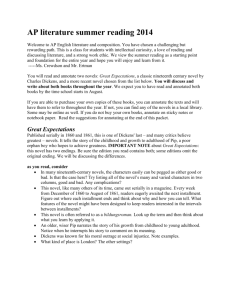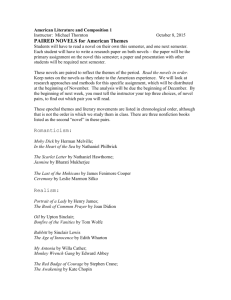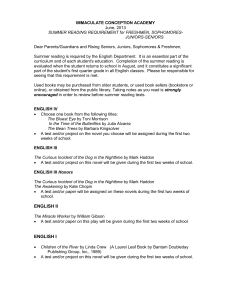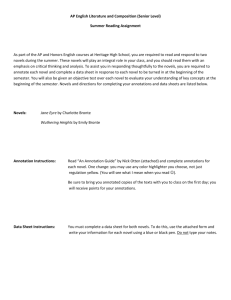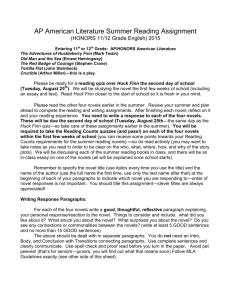2015 12th Grade AP Literature and Composition Summer Reading
advertisement
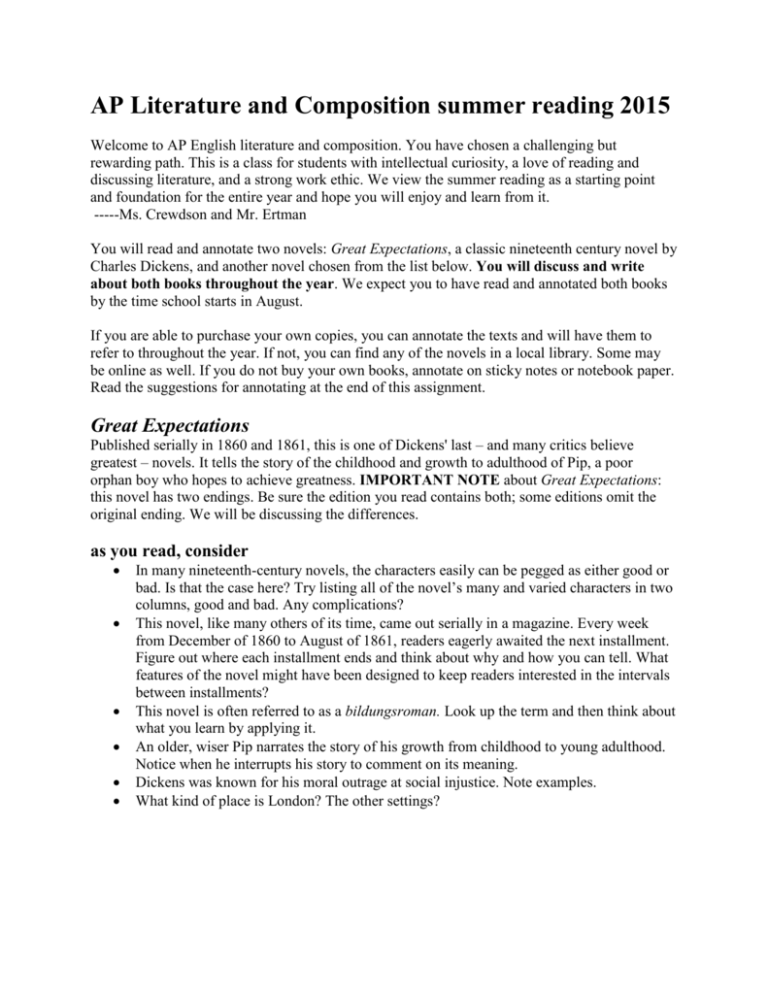
AP Literature and Composition summer reading 2015 Welcome to AP English literature and composition. You have chosen a challenging but rewarding path. This is a class for students with intellectual curiosity, a love of reading and discussing literature, and a strong work ethic. We view the summer reading as a starting point and foundation for the entire year and hope you will enjoy and learn from it. -----Ms. Crewdson and Mr. Ertman You will read and annotate two novels: Great Expectations, a classic nineteenth century novel by Charles Dickens, and another novel chosen from the list below. You will discuss and write about both books throughout the year. We expect you to have read and annotated both books by the time school starts in August. If you are able to purchase your own copies, you can annotate the texts and will have them to refer to throughout the year. If not, you can find any of the novels in a local library. Some may be online as well. If you do not buy your own books, annotate on sticky notes or notebook paper. Read the suggestions for annotating at the end of this assignment. Great Expectations Published serially in 1860 and 1861, this is one of Dickens' last – and many critics believe greatest – novels. It tells the story of the childhood and growth to adulthood of Pip, a poor orphan boy who hopes to achieve greatness. IMPORTANT NOTE about Great Expectations: this novel has two endings. Be sure the edition you read contains both; some editions omit the original ending. We will be discussing the differences. as you read, consider In many nineteenth-century novels, the characters easily can be pegged as either good or bad. Is that the case here? Try listing all of the novel’s many and varied characters in two columns, good and bad. Any complications? This novel, like many others of its time, came out serially in a magazine. Every week from December of 1860 to August of 1861, readers eagerly awaited the next installment. Figure out where each installment ends and think about why and how you can tell. What features of the novel might have been designed to keep readers interested in the intervals between installments? This novel is often referred to as a bildungsroman. Look up the term and then think about what you learn by applying it. An older, wiser Pip narrates the story of his growth from childhood to young adulthood. Notice when he interrupts his story to comment on its meaning. Dickens was known for his moral outrage at social injustice. Note examples. What kind of place is London? The other settings? choice novels From this list, pick a novel that you will enjoy reading in summer, as well as re-reading and using as a basis for an analysis paper during the first semester. Take some time to learn about the novels and sample them before you settle on one. Making a careful, informed selection is an important part of this assignment. Emma Jane Austen Jane Eyre Charlotte Brontë Middlemarch George Eliot Tess of the d’Urbervilles Thomas Hardy East of Eden John Steinbeck The Plague Albert Camus Their Eyes Were Watching God Zora Neale Hurston A Passage to India E.M. Forster The Heart is a Lonely Hunter Carson McCullers One Hundred Years of Solitude Gabriel Garcia Marquez The Ghost Writer Philip Roth Beloved Toni Morrison Blindness Jose Saramago Atonement Ian McEwan The Poisonwood Bible Barbara Kingsolver A Thousand Acres Jane Smiley ideas for annotating novels Think of annotation as part of active reading—something you do for yourself to stay engaged and to create a record that will help you think and write about the novel later. Learn to do this in a way that leaves a useful record of your reading but that does not interfere with the experience. Achieving that balance takes practice. Mark passages that jump out at you because they suggest an important idea or theme. Mark passages that puzzle, intrigue, please, or even displease you. Note patterns such as repeated images or phrases. Ask questions, make comments – talk back to the text. At the ends of chapters or sections, quickly write a bulleted list of key plot events. This practice forces you to think about what happened and identify patterns. You end up with a convenient record of the whole plot. Circle words you want to learn or words that jump out at you for some reason. If you don’t want to stop reading, just guess at the meaning of such words. Later, look the words up and jot down relevant meanings for each. You need not write out a full dictionary definition; it is often helpful to put the relevant meaning in your own words. P.S. This class represents a big step toward the independence you will experience as a college student. We will not collect or grade your annotations. But we believe learning to annotate effectively and efficiently is crucial. We strongly urge you to do it.
